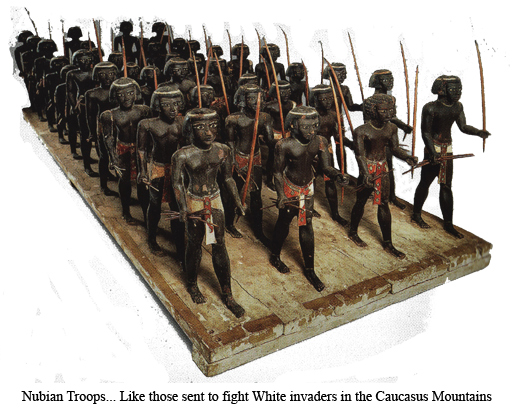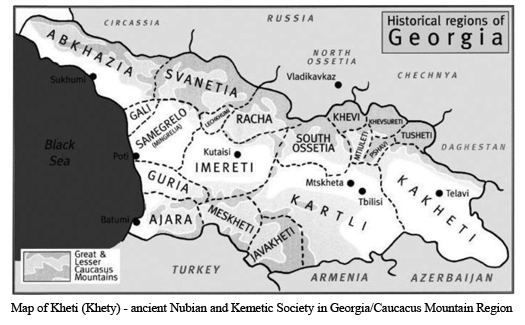
Kheti (Khety): A Nubian Society In Asia Minor - by Heru-Ka Anu
Khety (Kheti) Abroad
 Herodotus visited with African (Black) people of 'ancient Georgia' - people he referred to as Colchians and their land as Colchis... He thought of them to be from Kemet (Egypt)... He wrote:
p. 165 (104) "There is no doubt that the Colchians are an Egyptian race. Before I heard any mention of the fact from others, I made inquiries on the subject both in Colchis and in Egypt, and I found that the Colchians had a more distinct recollection of the Egyptians, than the Egyptians had of them. Still the Egyptians said that they believed the Colchians to be descended from the army of Sesostris.
My own conjectures were founded, first, on the fact that they are black skinned and have woolly hair; which certainly amounts to but little, since several other nations are so too; but further and more especially, on the circumstance that the Colchians, the Egyptians, and the Ethiopians, are the only nations who have practiced circumcision from the earliest times..."
Herodotus visited with African (Black) people of 'ancient Georgia' - people he referred to as Colchians and their land as Colchis... He thought of them to be from Kemet (Egypt)... He wrote:
p. 165 (104) "There is no doubt that the Colchians are an Egyptian race. Before I heard any mention of the fact from others, I made inquiries on the subject both in Colchis and in Egypt, and I found that the Colchians had a more distinct recollection of the Egyptians, than the Egyptians had of them. Still the Egyptians said that they believed the Colchians to be descended from the army of Sesostris.
My own conjectures were founded, first, on the fact that they are black skinned and have woolly hair; which certainly amounts to but little, since several other nations are so too; but further and more especially, on the circumstance that the Colchians, the Egyptians, and the Ethiopians, are the only nations who have practiced circumcision from the earliest times..."
(105) "I will add a further proof of the identity of the Egyptians and the Colchians. These two nations weave their linen in exactly the same way, as this is a way entirely unknown to the rest of the world; they also in their whole mode of life and in their language resemble one another..."
Herodotus gave an eyewitness account, however there have been, and are ongoing, efforts by Euro-centrist (White racists) to discredit his account as fictitious, or even worse, as lies.
Herodotus' believed the Colchians "to be descended from the army of Sesostris..." [a Greek name] of the Nsut Bity Senwosret III of the 12th dynasty (1991-1782 B.C.E.). Nsut Bity Senwosret III conducted military campaigns in defense of the Black societies bordering the Mediterranean Sea, and elsewhere, thwarting invading hordes of White barbarians. Of course the White racists 'scholars' would rather have everyone believe that these were White societies being invaded by White people.
 However, evidence proves Herodotus was telling the truth. A map of the areas Herodotus visited that he called Colchis, now called Georgia, helps to make the case. Several of the territories he referred to as Colchis bore the name Kheti (Khety) - JavaKheti, KaKheti, and MesKheti; herein lay the evidence. Colchis is the Greek name; however, it is evident that the name of the area was Kheti (Khety).
Herodotus said: "There is no doubt that the Colchians are an Egyptian race... they are black skinned and have woolly hair..." also writing: "I found that the Colchians had a more distinct recollection of the Egyptians, than the Egyptians had of them." Separated by distance and time would make the last statement understandable, for at least a thousand years had passed since the time of Senworsret III (Sesostris).
However, evidence proves Herodotus was telling the truth. A map of the areas Herodotus visited that he called Colchis, now called Georgia, helps to make the case. Several of the territories he referred to as Colchis bore the name Kheti (Khety) - JavaKheti, KaKheti, and MesKheti; herein lay the evidence. Colchis is the Greek name; however, it is evident that the name of the area was Kheti (Khety).
Herodotus said: "There is no doubt that the Colchians are an Egyptian race... they are black skinned and have woolly hair..." also writing: "I found that the Colchians had a more distinct recollection of the Egyptians, than the Egyptians had of them." Separated by distance and time would make the last statement understandable, for at least a thousand years had passed since the time of Senworsret III (Sesostris).
Nevertheless, the names of the territories visited by Herodotus bear the smoking gun, for Kheti (Khety) is an ethnic name found in the Black societies of Kemet and Nubia. For example, during Kemets Ninth -Tenth Dynasties at least three Nsut Bity (pharaohs) bore the name Khety (Kheti) - Nebkaure Khety, Meryibre Khety, and Wahkare Khety. Additionally, there is Khety who served under Nsut Bity Nebhepetre Mentuhotep II (11th Dynasty). And there is 'The Teaching of Khety for His Son Merikare'... of the 12th dynasty (p. 161 Oppenheim) - the Dynasty of Nst Bity Senwosret III. (Leprohon, Oppenheim)

Though Herodotus referred to the population as Egyptian, because of their race - color, complexion, and customs - they were also, and most likely, Nubians (his Ethiopian). This we know because the name Khety (Kheti, Khenti) is a Nubian ethnic name (Budge).
A bit of background and distinction is in order. It should be understood that, in contrast to Kemet, Nubia was not a writing society, not that they could not write or were not familiar with writing, they were; their faith (Way of Life) considered the 'living-word' - oral communication - to be sacred. Consequently, what we know about Khety in writing comes from Kemet. An examination of the Kemetic writing indicates that Khety (Kheti, Khenti), refers to Nubia, Nubians, Lands to the south of Kemet, etc.
Furthermore, with respect to Kemetic translations of the names - MesKheti translates as Birth (Mes) of Kheti; while KaKheti translates as Spirit (Ka) of Kheti. (Budge).
As to the possibility of "Colchian" troops being from Kemet/Nubia there is no doubt. Senwosret III did conduct military campaigns in the areas, as did several Nst Bity before him.
Evidence shows that as early as 2,300 B.C.E. Black (African) societies in the areas of the Caucasus Mountains (north, west, and south) and Mesopotamia (including Assur and Sumer) came under attack by invading White hordes. In response, Kemet and Nubia sent troops to support the Black societies and to defend against the invaders. Troops were permanently stationed there to prevent further incursions through the Caucasus Mountains by the White hordes, resulting in additional Black settlements in the areas. There are many stories (some called myths) in Russian Literature that recount wars with armies from Kemet. (Dixon-Kennedy)
 Eleventh thru thirteenth Dynasty representations and images are replete with Kemetic scenes of war and conquest, particularly of conquered foreigners.
Models of Nubian and Kemetic troops from the Eleventh Dynasty tomb of Mesehti represent the battalions that were likely sent by Nsut Bity Mentuhotep II, Amenemhat I, Senwosret III, and others to protect and defend against the White hordes. A painted scene from the tomb of Intef during the reign of Mentuhotep II - ca. 2051-2000 B.C.E. (Eleventh Dynasty) show Kemetic troops defeating invaders in a Canaanite town. A painted scene from the tomb of Khnumhotep II (Twelfth Dynasty) illustrates the conquered Aamu, subjects of Nsut Bity Amenemhat II and Senwosret II, paying tribute.
Eleventh thru thirteenth Dynasty representations and images are replete with Kemetic scenes of war and conquest, particularly of conquered foreigners.
Models of Nubian and Kemetic troops from the Eleventh Dynasty tomb of Mesehti represent the battalions that were likely sent by Nsut Bity Mentuhotep II, Amenemhat I, Senwosret III, and others to protect and defend against the White hordes. A painted scene from the tomb of Intef during the reign of Mentuhotep II - ca. 2051-2000 B.C.E. (Eleventh Dynasty) show Kemetic troops defeating invaders in a Canaanite town. A painted scene from the tomb of Khnumhotep II (Twelfth Dynasty) illustrates the conquered Aamu, subjects of Nsut Bity Amenemhat II and Senwosret II, paying tribute.

From 2500 B.C.E. to 500 B.C.E - some 2,000 years later - White hordes continued their invasions into the Black societies... It is amazing and a testament to the military prowess and resilience of the Nubians/Kemetians that the Black society of Khety was still in place during the time of Herodotus' visit more than a thousand years after Nst Bity Senworsret III, and others before and after him, sent troops to the Caucasus Mountains region to defend against the invading White hordes. And despite the continued White invasions and their ultimate conquest, 2,500 years later - since the time of Herodotus - the name remained to tell the truth of the Black Nubian/Kemetic society/societies of Khety (Kheti).
Bibliography:
The Great Name: Ancient Egyptian Royal Titulary - Ronald J. Leprohon (SBL 2013)
Ancient Egypt Transformed: The Middle Kingdom - ed. Adela Oppenheim, Dorothea Arnold, et. al. (The Metropolitan Museum of Art, NY / Dist. by Yale Univ Press)
The Persian Wars - Herodotus, trans Rawlinson
The Literature of Ancient Georgia: A History - Donald Rayfield (Routledge, 2000) - source for map
An Egyptian Hieroglyphic Dictionary (2 vols.) E.A. Wallis Budge (Dover, 1978 reprint)
Encyclopedia of Russian and Slavic Myth and Legend - Mike Dixon-Kennedy (ABC-ClIO)
© 2021 Heru-Ka Anu